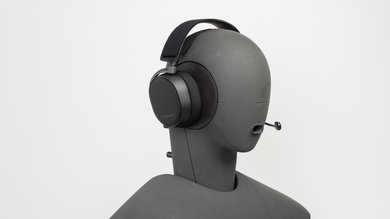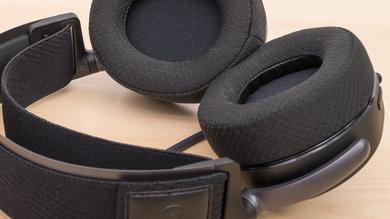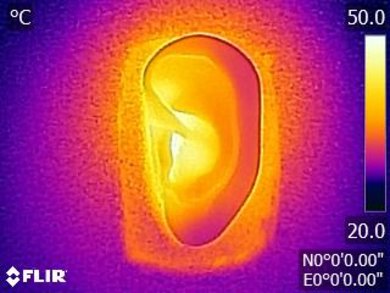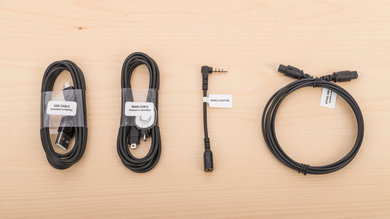The SteelSeries Arctis Pro GameDAC are good wired gaming headphones that are comfortable enough for longer gaming sessions and come with a DAC that offers a lot of connectivity options as well as customization features. Although they have inconsistent bass and treble delivery across users, the DAC allows you to EQ on the fly, helping you get the right sound for your needs. It even allows you to channel mix and toggle DTS virtual surround sound. These headphones are also easily customizable via their companion software. Unfortunately, they aren't very well-built or durable.
Our Verdict
The SteelSeries Arctis Pro GameDAC are alright for neutral sound. While their bass and treble delivery depend on their fit, seal, and positioning, the DAC makes it easy to tweak the way they sound on-the-fly thanks to their built-in EQ. The companion software also has a graphic EQ available and you can save your configurations for later use.
- DAC offers sound customization features and connectivity options.
- Wired design eliminates lag.
- Great overall microphone performance.
- Bass and treble delivery varies significantly across users.
- Bulky design.
- Can fit a bit tight for some listeners.
The SteelSeries Arctis Pro GameDAC are disappointing for commuting. They hardly reduce any background noise in the bass range such as bus or train engines and their bulky design makes it hard to take with you on the go. On the upside, they're comfortable enough to wear for multiple hours and they don't have a battery so you don't have to worry about recharging them.
- DAC offers sound customization features and connectivity options.
- Wired design eliminates lag.
- Great overall microphone performance.
- Bass and treble delivery varies significantly across users.
- Bulky design.
- Can fit a bit tight for some listeners.
The SteelSeries Arctis Pro GameDAC are sub-par for sports. They're bulky but are stable enough to stay on your head during a light jog. They're also comfortable and they have breathable padding around their ear cups but they can trap in sweat if you're doing more strenuous exercise. The audio cable can also snag on things while you move and these headphones may get yanked from your head.
- DAC offers sound customization features and connectivity options.
- Wired design eliminates lag.
- Great overall microphone performance.
- Bass and treble delivery varies significantly across users.
- Bulky design.
- Can fit a bit tight for some listeners.
The SteelSeries Arctis Pro GameDAC are mediocre for office use. While they're comfortable enough to be worn for multiple hours and you don't ever have to worry about pausing to recharge them, they really struggle to block out mid-range noise like background chatter. They also tend to leak sound, especially if you're listening to your music at a higher volume.
- DAC offers sound customization features and connectivity options.
- Wired design eliminates lag.
- Great overall microphone performance.
- Bass and treble delivery varies significantly across users.
- Bulky design.
- Can fit a bit tight for some listeners.
The SteelSeries Arctis Pro GameDAC are wired-only headphones and can't be used wirelessly.
The SteelSeries Arctis Pro GameDAC are good for wired gaming. They're comfortable and their wired design means you don't have to worry about lag. While they can sound different depending on who's wearing them, the DAC has a built-in EQ that allows you to tweak the sound to your liking on-the-go. The DAC also allows you to control channel mixing and it offers more connection options. Their retractable boom microphone captures voice clearly and can it can separate voice from background noise. Unfortunately, they aren't extremely well-built, as the yokes and hinges are prone to cracking and breaking.
- DAC offers sound customization features and connectivity options.
- Wired design eliminates lag.
- Great overall microphone performance.
- Bass and treble delivery varies significantly across users.
- Bulky design.
- Can fit a bit tight for some listeners.
The SteelSeries Arctis Pro GameDAC are alright for phone calls. The retractable boom microphone captures voice clearly and does a good job of separating speech from noisy environments like a gaming tournament. However, these headphones don't really reduce background noise, so you may struggle to hear whoever you're talking to on the other line.
- DAC offers sound customization features and connectivity options.
- Wired design eliminates lag.
- Great overall microphone performance.
- Bass and treble delivery varies significantly across users.
- Bulky design.
- Can fit a bit tight for some listeners.
Changelog
- Updated Jan 05, 2023: The headphones' build quality was reevaluated based on widespread complaints about the hinges cracking and breaking from regular use. The score changed from 8 to 6.
- Updated Feb 14, 2022: Retested 'Connection' and 'USB Audio' in our Wired test.
- Updated Oct 27, 2021: Converted to Test Bench 1.5.
- Updated Jan 28, 2021: We've updated the Build Quality text to better clarify the materials used in their design.
Check Price
Popular Headphones Comparisons
The SteelSeries Arctis Pro GameDAC are good wired gaming headphones. They have a comfortable design and offer a lot of customization and connection options. They also come with a DAC that makes them a good choice for gaming on PC, but they aren't as convenient as some of the wireless models below for gaming on consoles. Unfortunately, users have reported that the hinges tend to crack or break, so they aren't very durable.
See our recommendations for the best headsets for Xbox One and the best PS4 headsets.
The SteelSeries Arctis Nova Pro and the SteelSeries Arctis Pro GameDAC are similarly performing wired gaming headphones, meaning you may prefer either one. While both headphones are comfortable and have similar sound profiles, Arctis Nova Pro's boom mic offers a better recording quality. They also have more customizability via their companion app, and they use a 1/8" TRRRS cable instead of a mini B 8-pin, which makes it easier to replace if it gets damaged.
The SteelSeries Arctis Pro GameDAC and the Logitech G Pro X Gaming Headset are both similarly-performing wired gaming headphones that perform well. The Arctis feel a bit more stable, have a less bass-heavy default sound profile, and more wired connectivity options. On the other hand, the Logitech look and feel more comfortable and durable, and have a better control scheme. Both headphones have a boom mic that performs very well, but the Logitech's is detachable, which can be handy.
While the SteelSeries Arctis Pro GameDAC and the HyperX Cloud Alpha are similarly performing wired gaming headphones with great boom microphones, the SteelSeries offer slightly more features. Both headphones have inconsistent bass and treble delivery but only the SteelSeries offer a companion app with a graphic EQ plus presets so you can tweak the sound to your liking. They also have DTS 7.1 virtual surround support, and their controls allow you to channel mix on the fly. On the other hand, the HyperX are slightly more comfortable and have a better build quality.
The SteelSeries Arctis Pro GameDAC and the Astro A40 TR Headset + MixAmp Pro 2019 are both impressive headphones for wired gaming. The open-back Astro have a better mic and reproduce audio more consistently across users, but are a bit boomy in the bass. The SteelSeries’ audio reproduction depends a lot on who’s wearing them, but they come with a great onboard 10-band EQ, so you can quickly customize their sound to meet your needs on-the-fly.
Test Results

The SteelSeries Arctis Pro GameDAC have a similar ski-band headband as the SteelSeries Arctis 7 Wireless 2017 but are more curved to better fit your head. These headphones also feel durable and premium too. You can even make them look slightly more casual by retracting the boom microphone into the left ear cup.
The SteelSeries Arctis Pro GameDAC are comfortable headphones. The ear cups spacious and have soft and breathable padding which makes them easy to wear for long gaming sessions. They also have the same adjustable, elastic ski-band headband as the Arctis 7 2019 Edition Wireless. However, as the headband can only expand to the length of the metal headband, users with larger heads may find this fit tight.
Although they're wired and don't have call or music controls, The SteelSeries Arctis Pro GameDAC have a similar control scheme to the SteelSeries Arctis Pro Wireless. The headset has a volume dial and a microphone mute/unmute switch while the DAC has a channel mixing dial that can also act as a multi-function button when pressed and held, allowing you to switch between presets and EQ modes. All the buttons provide great feedback while being decently easy-to-use.
The SteelSeries Arctis Pro GameDAC have disappointing breathability. Although the ear cups are made with porous padding, they're still closed-back, over-ear headphones and can make you sweat, especially if you're wearing them while working out. However, if you're just wearing them for casual gaming, they shouldn't get too warm.
Like most gaming headsets, including the Turtle Beach Elite Pro 2 SuperAmp, these headphones aren't very portable. They have large ear cups, a rigid headband, and can't fold up into a more compact size. Their DAC also makes them less than portable but you can always use them passively with their audio cable and adapter if you're on the go. However, due to their size, you can only store them in a bag or backpack.
The SteelSeries Arctis Pro GameDAC don't come with a carrying case or pouch.
These headphones have a mediocre build quality. They feel well-built and have dense plastic earcups and a headband made of metal and silicone-like plastic. You can remove the magnetic backplates, and the microphone has a flexible design. However, users commonly report that their headphones' hinges or yokes cracked or broke off completely after using them for a while. The issue seems widespread, so they aren't the most durable headphones.
The SteelSeries Arctis Pro GameDAC fit decently tight on the head and shouldn't move around too much. While they're stable enough for playing video games at your desk or on the couch, they're still bulky and wired, which makes them less than ideal for physical activity or sports. The cable can also snag on something such as a table corner and yank them off your head.
The SteelSeries Arctis Pro GameDAC's sound profile depends on how they fit on your head. Their position, seal, and whether you have glasses or thick hair can all affect sound delivery, resulting in inconsistent bass and treble. Once properly fitted to your head however, you should be able to get a consistent sound. Still, thanks to their DAC, you can easily tweak the sound to your liking using its built-in EQ.
The frequency response consistency of the SteelSeries Arctis Pro GameDAC is disappointing. The bass delivery varies and a drop in bass can occur if the ear cups are not flush to your head or if you have glasses. The treble range is also inconsistent. As the overall frequency response depends on fit, seal, and positioning of these headphones, once you achieve a good overall fit, you should get a more consistent frequency response each time you use them.
Just like the SteelSeries Arctis Pro Wireless, the SteelSeries Arctis Pro GameDAC have excellent bass accuracy but its delivery can vary across users. Although there's a small dip in the mid-bass that slightly reduces body and punch, the response is otherwise very even without being boomy or muddy. However, the bass delivery can be sensitive to fit, seal, and whether you have thick hair or glasses so make sure you take the time to properly adjust them. This bass accuracy performance represents the average response and your experience may vary.
The SteelSeries Arctis Pro GameDAC have great mid accuracy and is fairly even and flat. However, there's a dip in the high-mid that makes vocals and lead instruments sound weak and distant.
The SteelSeries Arctis Pro GameDAC have mediocre treble accuracy but delivery can vary across users. Overall, it's fairly underemphasized and its low-treble can make vocals and lead instruments sound veiled and lacking in detail. While the mid-treble is slightly better, its underemphasis makes sibilants like cymbals or S and T sounds dull and lispy. However, this treble accuracy performance represents the average response and your experience may vary.
While the SteelSeries Arctis Pro GameDAC's peaks and dips performance is good, their position, seal, and whether you have glasses or thick hair can all affect sound delivery, resulting in inconsistent bass and treble. Still, there's a lot of very small peaks and dips that can slightly affect your mix. However, the dip in the low treble can make voices sound dull and lispy while the rise into the mid-treble can make sibilants like S and T sounds piercing and sharp.
The imaging performance of the SteelSeries Arctis Pro GameDAC is excellent. While there are some peaks in the low-bass range that are above the group delay's audibility threshold, it may not be audible for most users. Additionally, the L/R drivers of our test unit are exceptionally matched, which is important for the accurate placement and localization of objects and instruments (like voices and footsteps) in the stereo image. However, these results are only valid for our unit and yours may perform differently.
The soundstage of the SteelSeries Arctis Pro GameDAC is mediocre. While the soundstage feels large and sounds like it's coming from the front of the user rather than inside the head, it can be perceived as unnatural and lacking spaciousness. As they're closed-back headphones, their soundstage may also not feel as open as open-back headphones.
The SteelSeries Arctis Pro GameDAC have DTS virtual surround support and a simple speaker modeling feature.
The SteelSeries Arctis Pro GameDAC's weighted harmonic distortion is good. While there's some distortion between the low to mid-bass and in the low-treble range, it's very slight and likely won't be noticeable to all listeners.
The SteelSeries Arctis Pro GameDAC's results are only valid for these settings.
The SteelSeries Arctis Pro GameDAC's noise isolation performance is disappointing. They don't block out any of the low rumble of bus and train engines and they barely cut mid-range noise like chatter. However, they can significantly reduce higher-pitched sounds like the hum of an A/C unit.
The SteelSeries Arctis Pro GameDAC have an okay leakage performance. The significant portion of leakage is found between the mid-mid to mid-treble ranges. If you like to listen to your music at a high volume and you're using them in an office setting or a similarly noisy environment, those closest to you may hear some of your audio.
This headset has a boom microphone.
The SteelSeries Arctis Pro GameDAC's boom mic has a good recording quality. Your voice sounds full, clear, and detailed so you shouldn't have any problems being understood by your teammates. However, there's a small bump in the treble that can make speech sound overly bright or sharp.
The SteelSeries Arctis Pro GameDAC's boom microphone is great at noise handling. It easily separates speech from ambient noise, even in loud environments like a gaming tournament.
The SteelSeries Arctis Pro GameDAC don't have a battery.
The SteelSeries Engine is great companion software that offers a lot of customization features. It offers a graphic equalizer with presets, DTS surround sound, live preview, mic monitoring, and mic volume control. You can also save your customization in the configuration tab so that you can quickly switch between different settings on the fly.
The SteelSeries Arctis Pro GameDAC don't have Bluetooth connectivity. If you want a gaming headset that also supports Bluetooth, check out the Turtle Beach Elite 800 Wireless.
The SteelSeries Arctis Pro GameDAC can only be used wired.
The SteelSeries Arctis Pro GameDAC use an uncommon mini B 8-pin connector cable, which may be hard to find if you need to replace it. It also comes with an analog audio adapter so that you can listen to your favorite tunes on most devices. These headphones have voice support if you connect to your PS4 controller using the USB cable. However, if you're on the Xbox One, this USB cable only gives you audio support, so you won't be able to use your microphone.
These headphones have a DAC that adds a negligible amount of latency. You shouldn't notice any delay when gaming or watching movies.
The SteelSeries Arctis Pro GameDAC are compatible with the Xbox One. If you plug them into your controller via an analog cable, you can use your microphone and receive audio. If you want to use a wired USB connection with this console, you'll only receive audio support and won't be able to use your microphone. You will need to change your Xbox One's audio output settings, but SteelSeries provides straightforward instructions here.
These headphones come with a digital to analog converter (DAC) that has multiple inputs such as an optical-in, line-in, USB, and a line-out. Although the DAC is larger than that of the HyperX Cloud 2/Cloud II, it puts controls such as switching EQs or surround sound settings within easy reach, allowing you to tweak your audio experience on the fly.















